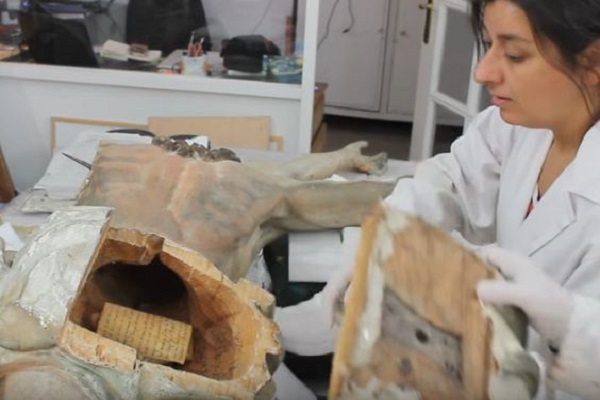
240-Year-Old Secret Message Found in Jesus Statue’s Rear End
- By Kelly Frazier --
- 05 Dec 2017 --

The statue of Jesus was dated back to the 18th century.
The Jesus Christ statue on display at the Santa Agueda church in Sotillo de la Ribera, Spain had hidden a secret message from the 18th century[/tweetit]. It is notable that the message, a veritable time capsule, was found in the buttocks of the statue. It was found by restorers employed by Da Vinci Restauro, a restoration company, when they were asked to restore the sculpture.
240-Year-Old Secret Message Found in Jesus Statue’s Rear End[/tweetthis]
Efren Arroyo, a historian and who also holds membership of Sotillo de la Ribera's Holy Week Brotherhood, noted that although it is quite common for sculptures to be empty inside, it is extremely unusual to find a message inside them. Handwritten documents are rarely found inside hollow statues. Restorers found the message by accident when they took away the cloth which used to cover the butt of the statue.
An examination of the document – over two pages long – established its author, Joaquin Minguez, a chaplain deputed to Cathedral of Burgo de Osma. The letter discussed the qualities of the statue where it was found. The document also expressed in some detail the sculptor, Manuel Bal, and other statues crafted by him. Bal is elaborated on as San Bernardo de Yague's natural scholar and the author's neighbor. Both of them lived in Campillo and belonged to the Bishopric of Osma. Other sculptures made by Bal for the Sotillo de la Ribera church altar include the ones of saints Juan, Santiago, Jeronimo, and Millan.
The note provides a succinct description of life as it was about two centuries and 40 years before. The priest gave an excellent description of cards and other games popular at that time. He wrote that sicknesses like malaria and typhoid were quite common. The note also revealed the fact that the list of principal crops included wheat, oats, rye, and barley. The author even provided a quick reference to his hometown and mentioned the plentiful harvest which happened that year. It said that King Carlos III was reigning Spain at that time. There was also a fairly comprehensive list of aldermen in service at that time, complete with their respective names.
The archbishop will receive the original document, and a copy will be taken by the historians. Another copy was put back into the statue, at the same place, for posterity.
'The video shows two art restorers pulling off a section of the Jesus statue's bum and uncovering the rolled-up paper like some kind of Kinder surprise egg.'
A Priest Used Jesus's Butt as a Time Capsule https://t.co/bU4tQo1nvS
— Stan Yee (@stanyee) December 4, 2017


















